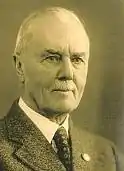Franz von Reichenau
Franz von Reichenau (born 6 October 1857 in Wiesbaden, died in 1940) was a German diplomat and jurist.
Franz von Reichenau | |
|---|---|
 A portrait of Franz von Reichenau | |
| Born | 6 October 1857 |
| Died | 1940 |
| Nationality | German |
| Occupation | Diplomat |
Early life and diplomatic career
Franz von Reichenau was a son of the Prussian administrative director Fritz von Reichenau. From 1878 to 1880 he studied law in Strasbourg and Berlin.
From 1903 to 1907 he was the German ambassador to the government of Germán Riesco Errázuriz in Santiago de Chile and at the same time accredited to the government of Manuel José Estrada Cabrera in Guatemala . From 1907 to 1908 he was ambassador in Rio de Janeiro[1] where he played a leading role in negotiations related to the laying of sub-sea trans-Atlantic cables.[2] From 1909 to 1911 ambassador in Belgrade and from 1911 to 1914 ambassador in Stockholm. In early 1915 he was ambassador to Argentina.
His time as ambassador to Sweden was particularly fraught, as he engaged in a number of attempts to persuade the Swedish government to side with Germany in the First world war. Eventually he was expelled by the Swedish government for this. He was a strong support of Wilhelmine governance and an opponent of parliamentarism, and even considered that Sweden might one day be part of the German Empire.[3] His replacement in the role was Helmuth Lucius von Stoedten, an opponent of Swedish activism.[4]
Later life
In 1919 he and his wife Käthe (née Peipers) acquired Rotenberg Castle, which he finished rebuilding in 1922.[5] He financed various infrastructure projects, such as the construction of Schlossstrasse and Oberer Schlossstraße 1921-1923. The gratitude of the people of Rotenberg is expressed to this day in the memorial stone for road construction (which was set up in the second turn opposite the castle): "This way was 1921/22 under Mayor Menges of the municipality Rotenberg and the lord of the castle Excellency von Reichenau by the water and Road Construction Office Sinsheim built". The street between the Hofacker and the Schloßstraße, which seemingly leads to the castle, bears the name "Von Reichenau Street", which is another visible sign of gratitude to von Reichenau visible to this day.
References
- Joseph, Gilbert M.; Rosenburg, Emily M.; Winseck, Dwayne R.; Pike, Robert M. (2007). Communication and Empire: Media, Markets, and Globalization, 1860–1930. Duke University Press. p. 213. ISBN 978-0822389996. Retrieved 7 September 2019.
- Ahvenainen, Jorma (2004). The European Cable Companies in South America: Before the First World War. Finnish Academy of Science and Letters. p. 297. ISBN 9514109473. Retrieved 7 September 2019.
- Small Nations and Colonial Peripheries in World War I. BRILL. 2016. p. 93. ISBN 978-9004310018. Retrieved 7 September 2019.
- Kuldkepp, Mart (2015). Hegemony and liberation in World War I: the plans for new Mare Nostrum Balticum (PDF). Ajalooline Ajakiri. p. 261. Retrieved 7 September 2019.
- "Judendburg Rotenburg: History". Jugendburg Rotenburg. Retrieved 8 September 2019.
